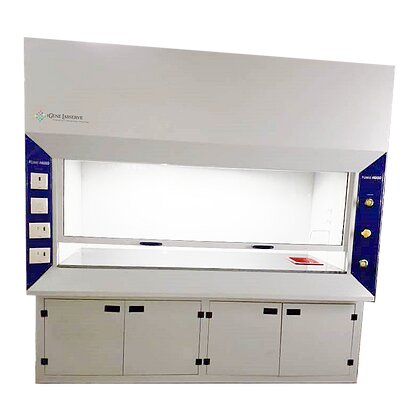A fume hood protects against dangerous or toxic gases, vapours, or airborne particulates by providing safe ventilation. A chemical fume hood is primarily intended to protect the user or the environment outside the hood in laboratory and production settings, but it can also be used to protect the materials or experiment inside the hood. To safely ventilate outside the building, duct fume hoods link to a remote exhaust system. A built-in fan and filtration system in ductless fume hood configurations filters and recirculates cleansed air.

Laboratory Fume Hoods
Activated carbon filters for the elimination of non-hazardous, nuisance odours are available as add-ons for laboratory fume hoods. To eliminate microscopic particles and germs, HEPA or ULPA filters can be added to a light duty fume hood. For volatile or combustible applications, explosion-proof fume hood designs are offered. When floor space is restricted, a wall-mounted fume hood gives you more options.
Types of Fume Hoods
- Light Duty Fume Hood – Basic benchtop fume hoods allow hazardous gases to be safely ventilated
- General Chemistry Fume Hood – For general chemistry, benchtop chemical fume hoods protect users from dangerous or toxic emissions
- Educational Fume Hood – Educational labs can benefit from laboratory fume hoods. On both sides, there are tempered glass viewing windows
- Ductless Fume Hood – A ductless fume hood is simple to set up and does not require ducting. Filters for acids, bases, and solvents can be used in a filtered fume hood
- Ducted Fume Hood – For safe ventilation outside the building, a ducted fume hood links to a remote exhaust system
Features and Benefits
Working Chamber – The most significant aspect of a fume hood is the inner working chamber or area, which is in direct contact with fumes, acids, and various chemicals. Inner chamber walls are made of stainless steel (304/316) and are optionally covered with a FRP layer. The standard chamber sizes are 2ft, 3ft, 4ft, 5ft, 6ft, and 8ft, among others.
External Surface – These cabinets have been ergonomically built to last a long time. To ensure the best and safest fume hood, only thick metal sheets and pipes are utilised in the construction. Three different MOCs are used.
- Complete Stainless Steel 304
- Galvanized Mild Steel Powder Coated
- Stainless Steel 316
Service Valves – Service valves can be tailored for wet and dry service, such as raw water, nitrogen gas, and air, based on the needs of the user.
Electrical Utilities – The fume hood 6A/15A connections can be supplied with 2 or 4 or 6 electrical sockets, depending on the user’s needs.
Sash – For up and down movement of the door, a glass window mechanism with counterbalanced weight is used. Weights and a pulley make up a sash track system. During work, the operator can effortlessly move the sash up or down and hold it at the proper height.
Chemical Storage Cabinet – At the bottom, ventilated cabinets are available in a variety of forms for chemical storage. On demand, consumers can also have lockable wheels.
iGene Labserve Pvt. Ltd. is quickly gaining a reputation among customers for demonstrating a rare level of resilience and fortitude in meeting their needs by providing scientific solutions in laboratory instrumentation for healthcare, genomics and proteomics, drug discovery, biopharma, and food and beverage labs. Visit https://www.igenels.com to find out more.